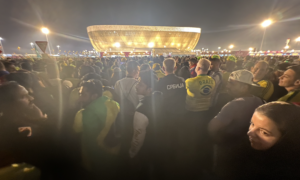That’s right, it’s another FIFA tournament. Much like ‘Despacito’ or the Kardashians, you can’t escape the amount of soccer news, fixtures or upcoming games surrounding you. It is both the curse and the blessing of the beautiful game. But don’t worry, we are here to guide your hand and walk you through the importance of this tournament:
What’s the Gold Cup?
The Gold Cup is CONCACAF’s sick joke to the federation’s national teams and its fans.
Actually, it was originally two different tournaments from two different federations within the region: Confederación Centroamericana y del Caribe de Fútbol (CCCF) and North American Football Confederation (NAFC) back in the 1940’s to 1960. In 1961, the two federations were merged, creating CONCACAF or Confederation of North, Central American and Caribbean Association Football. In 1963, the first official tournament entitled CONCACAF Campeonato de Naciones. Then CONCACAF changed the name once more in 1990, having the United States host the CONCACAF Gold Cup, an eight-team inaugural tournament that would be held every two years. In 2000, the federation increased the number of teams to twelve and recently, the federation announced an expansion to 16 teams in 2019 because the more the merrier apparently.
For the power teams of CONCACAF, the US National Team and El Tri, the Gold Cup has been validating. Since the formation of the tournament, Mexico has won the title seven times, the US fives times and Canada once.
Why is it Important?
(Whispers) Because CONCACAF wants more money.
It’s also a vanity project for the US and Mexico national teams. You remember playing Nintendo 64 and in the game Super Smash Bros, there were different levels? When you would play beginner, you could get to the very end where you faced Master Hand and it all felt so easy? That’s what Gold Cup is like for these two teams. It makes the national teams feel good about beating Link (aka Curacao) and even though there’s those “tough” moments of facing Metal Mario (Costa Rica) or Fox McCloud (Jamaica), overall, it’s not a tough journey.
That’s why when the teams get to the Confederations Cup, aka Expert Level, it gets more complicated and it reminds them where they are on the international level. But hey, here’s a small pond of the Gold Cup where they can be big fish.
What does this mean for El Tri?
Mexico’s focus was mostly on the Confederations Cup this summer and the expectations there fell short (cc: 4-1). Those participating in the Gold Cup have been deemed the “B” team but the expectations for the Gold Cup haven’t faltered. While the star-power on the team won’t be the same, there is still a general consensus that the team should make it to final if not win the tournament completely. There is also the recent announcement of FIFA suspending manager Juan Carlos Osorio for six games following the third place match against Portugal that could increase the worries of those that have long doubted him and his methods (and might start making people worry about him going hulk when he’s angry.)
Mexico’s bad luck has also floated to the Gold Cup squad, with striker Alan Pulido getting injured and fracturing his arm during a friendly against Paraguay on July 1st that has left him out of the tournament. However, there is strong promise for the young players that will be going to the Gold Cup such as Jorge “Burrito” Hernandez, Rodolfo Pizzaro and Orbelin Pineda. The replacement for Pulido, Erick “Cubo” Torres has a chance to show talent on the international stage after making great strides with Houston Dynamo.
The United States National Team will also be taking their own version of a “B” team which only raises the stakes higher in terms of whose future prospects have more to offer.
Mexico kicks off their Gold Cup run against El Salvador on July 9th in San Diego, CA.
Comments








